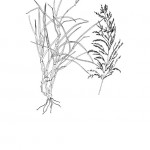Blue Panicum , Blue Panicgrass
Panicum antidotale
Poaceae
Description
Coarse stems grow from a dense crown of thick, short, bulbous rhizomes. Lower stems have large nodes and internodes with branches coming from the nodes. Leaves are 7 to 12 inches or 17.8 to 30.5 cm long, abundant, with wavy margins, and flat with a heavy midrib on the underside. Terminal panicles are long, loose, open, and usually erect, but droop slightly at maturity. The spikelets are greenish-yellow, very slick and shiny, and are borne on the tip of rather long seed branches. Flowering can occur from April to October. It produces abundant forage when managed as a pasture plant. The use of this grass for range reseeding has declined. Blue Panicum is a perennial, warm-season, introduced species that measures 48 to 84 inches or 122 to 213 cm tall. Good grazing for both livestock and wildlife. It can cause prussic acid poisoning in livestock at certain stages of growth.Habitat
Blue Panicum grows on clay loam soils and is found in open areas, disturbed locations, and fields. Its elevation ranges from 984 to 1969 ft or 300 to 600 m. Its distribution includes California, Utah, Texas, and parts of northern Mexico. Native to India.Images
Plant Characteristics
Seed Type: Non-Encapsulated
Duration: Perennial
Stem Texture: Hairless/Smooth
Growth Habit: Grasses, Sod grass
Leaf Shape
 : Simple with Pinnate or Parallel Venation
: Simple with Pinnate or Parallel Venation
Season: Warm
Distribution
 : 02 - Gulf Prairies and Marshes, 03 - Post Oak Savannah, 04 - Blackland Prairies, 05 - Cross Timbers and Prairies, 06 - South Texas Plains, 07 - Edwards Plateau, 08 - Rolling Plains, 10 - Trans-Pecos
: 02 - Gulf Prairies and Marshes, 03 - Post Oak Savannah, 04 - Blackland Prairies, 05 - Cross Timbers and Prairies, 06 - South Texas Plains, 07 - Edwards Plateau, 08 - Rolling Plains, 10 - Trans-Pecos
Distributions
Distribution refers to the ecological region in Texas that a plant has been found. You can also view a clickable map.
Book: Know Your Grasses (B-182)
Collection: Grasses


